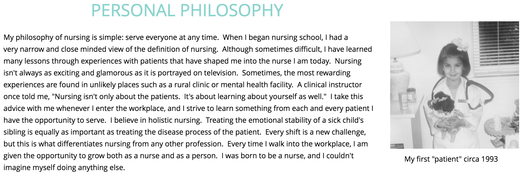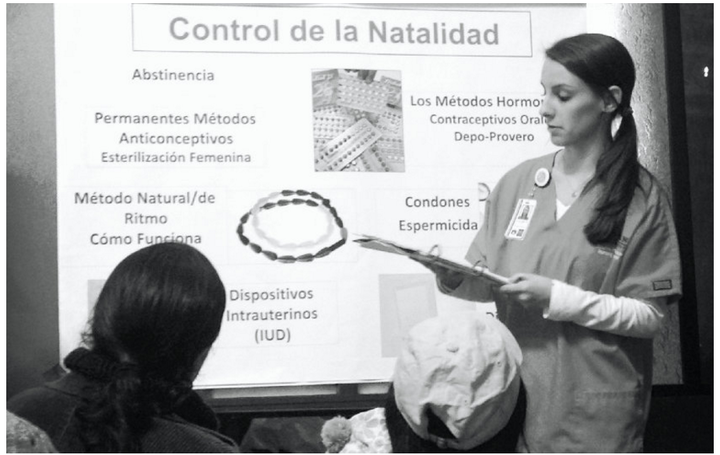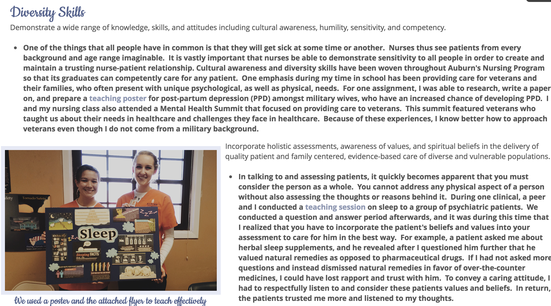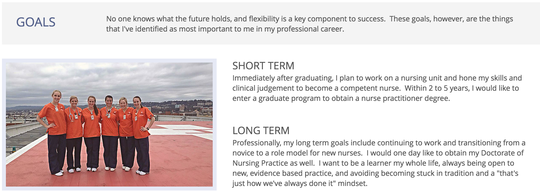The School of Nursing has been in the ePortfolio Project Cohort since it began. They had been using paper portfolios for over a decade in their capstone course, and they moved to electronic portfolios in 2008. Historically, the purpose of the portfolio (both paper and electronic) had been to assess how the students perceived they had mastered programmatic outcomes. The portfolio was primarily a place to house content, and students were assessed based on the separate pieces the portfolio contained — not on the portfolio as a whole.
Since joining the ePortfolio Project Cohort, the School of Nursing’s approach to ePortfolio implementation has evolved considerably. Because critical thinking and communication are so crucial for nursing practice (and are included as learning outcomes), faculty in the School of Nursing saw immediate connections between the student learning outcomes of the ePortfolio Project and their own disciplinary values. The School of Nursing moved past the concept of the ePortfolio as a digital replica of a paper portfolio, opening the possibilities for students to take full advantage of the technological affordances of a fully electronic and interactive portfolio (Arola, Sheppard, and Ball 2014, 14-19). Operating under the new approach, they revised the capstone assignment to be a professional, outward-facing ePortfolio and expanded the criteria to align with the ePortfolio Project learning outcomes that include effective communication, visual literacy, technical competency, and critical thinking through reflection. This integrated approach gives students an opportunity to extract deeper meaning out of their experiences, rather than simply checking boxes to fulfill a requirement. In the example below, one nursing student uses her philosophy statement to communicate how her professional beliefs and values have evolved over time. In other parts of her ePortfolio, she uses artifacts and reflective writing to describe her meaningful experiences in more detail.


Nursing also uses ePortfolios to enrich the teaching of discipline-specific practices. For example, Clinical Assistant Professor Kelley Noll prompts students to reflect on their antepartum and public health clinical rotations by using specific language and questions in this assignment. Patient privacy is another integral element of nursing practice. Notice how the student above enacts ethical visual representation by ensuring that the people in the photo from her study abroad program are not identifiable. For more on how the ePortfolio Project is working with faculty to teach Auburn students visual and ethical literacy, visit the Looking Ahead page.
In addition to their renewed emphasis on critical thinking through reflection in the ePortfolio, the School of Nursing was particularly drawn to the professional audience that the outward-facing element of the campus-wide initiative provides. In an article they wrote for Nursing Management: The Journal of Excellence in Nursing Leadership, Auburn faculty members Drs. Libba McMillan and Francine Parker and graduate student Andrea Sport write, “In order to ensure patients receive quality care and safe delivery of services, nurse hires must be adept at clinical reasoning and critical thinking, with the ability to efficiently navigate multidimensional patient care situations in coordination with members of an interprofessional team. They must also possess effective interpersonal verbal and written communication skills and be technologically savvy” (2014, 52). They see the ePortfolio not only as a way to help students practice these important skills and habits of mind but also as a tool for future employers to get a better sense of who the candidates for a position are and what they can do. For example, a potential employer who is committed to diversity might look through an ePortfolio to learn more about how a candidate has used their cultural awareness and diversity skills.

Students can also describe their professional goals and interests, which allows potential employers to see if someone is a good fit for the position. Even though the audience only sees a published version of the ePortfolio, creating an ePortfolio is an iterative process where students use reflective writing to learn more about themselves. McMillan, Parker, and Sport note, “Reflection is one of the most important aspects of e-portfolio because it can facilitate self-evaluation and development of future goals” (2014, 53). In the example below, a nursing student uses her ePortfolio to communicate her short- and long-term goals.

ePortfolio implementation in the School of Nursing shows what is made possible when faculty and students have choices. McMillan, Parker, and Sport write, “Faculty members determine the purpose of the e-portfolio and subsequently develop guidelines, which can be part of a Capstone course or, ideally, incorporated throughout the curriculum. By scaffolding artifacts that will ultimately be included in the final product, the student is allowed time to reflect, select, and arrange the e-portfolio in a meaningful way. The student can begin the process by selecting an e-portfolio platform for which numerous quality programs are available” (2014, 53). While the School of Nursing still requires that students use the ePortfolio, in part, to demonstrate their mastery of curricular outcomes, the shift to a professional, outward-facing ePortfolio that emphasizes identity performance, choice, and reflection has opened up the range of possibilities for what students can create to communicate their unique contributions as a professional nurse.